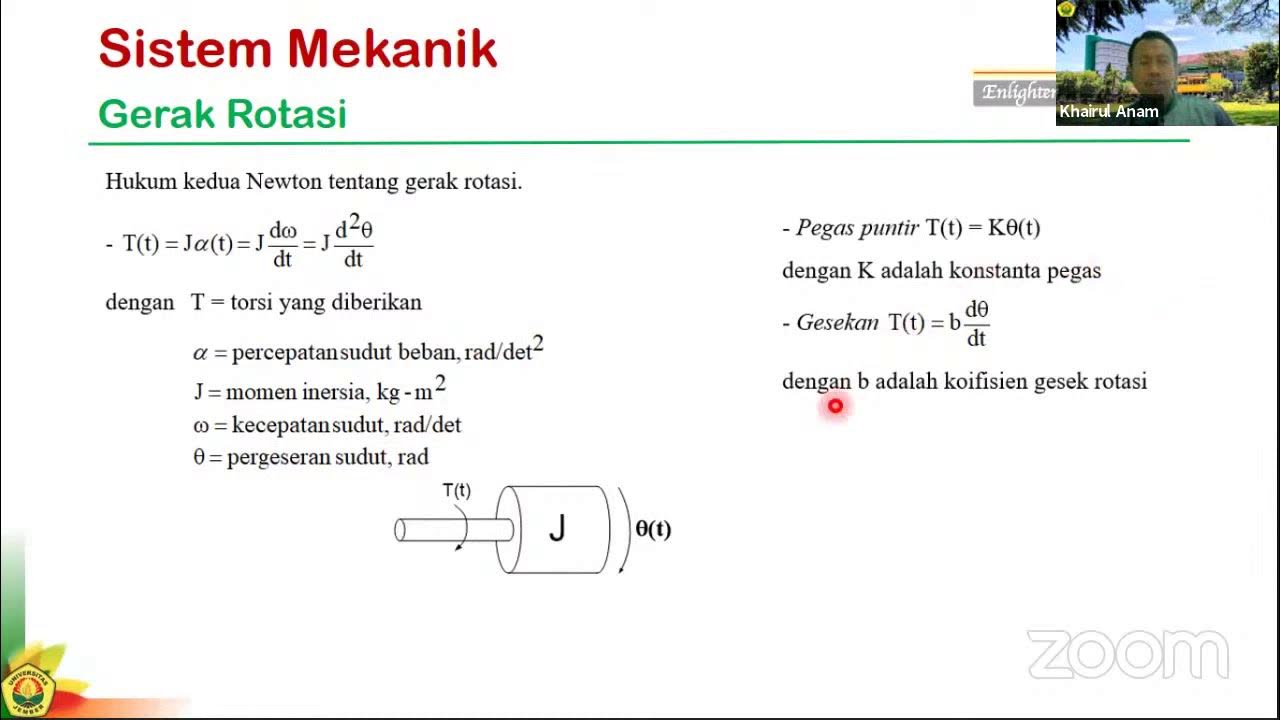Dinamika Partikel • Part 1: Hukum Newton Tentang Gerak
Summary
TLDRThis video provides an in-depth yet simple explanation of Newton’s Three Laws of Motion. It starts with the First Law, or the Law of Inertia, explaining how objects resist changes in motion with relatable examples like car acceleration and sudden stops. The Second Law connects force, mass, and acceleration, showing how they are interrelated. The Third Law introduces the concept of action and reaction, highlighting how forces work in pairs. Through easy-to-understand examples, the video helps viewers grasp these fundamental physics concepts, making them accessible for beginners.
Takeaways
- 😀 Newton's First Law states that if the net force on an object is zero, an object at rest will stay at rest, and an object in motion will continue moving with constant velocity.
- 😀 The concept of inertia (or 'kelembaman') explains how an object resists changes in its state of motion. This explains why we feel pushed back when a car accelerates suddenly or pushed forward when it decelerates.
- 😀 An object that is in motion with constant speed (without acceleration) will continue in that motion unless acted upon by an external force.
- 😀 Inertia causes our bodies to experience forces when a moving vehicle suddenly accelerates or decelerates.
- 😀 Newton's Second Law shows that the acceleration of an object is directly proportional to the net force and inversely proportional to the object's mass, expressed by the formula F = m * a.
- 😀 Acceleration is in the same direction as the applied net force. If the force is applied to the right, the acceleration will also be to the right.
- 😀 Newton's Third Law of Motion states that for every action (force), there is an equal and opposite reaction. This is illustrated by swimming, where pushing water backward moves the swimmer forward.
- 😀 The action-reaction principle means that when you apply a force to an object, the object applies an equal force back on you, but in the opposite direction.
- 😀 The magnitude of the action and reaction forces is always the same, but their directions are opposite.
- 😀 Newton’s laws are foundational to understanding motion, force, and how objects interact, and are crucial for solving related problems in physics.
Q & A
What does Newton's First Law state?
-Newton's First Law states that if the net force acting on an object is zero, the object at rest will remain at rest, and the object in motion will continue moving at a constant velocity.
What is another name for Newton's First Law, and what does it mean?
-Newton's First Law is also called the Law of Inertia. It means that an object tends to resist changes to its motion. If it’s at rest, it wants to stay at rest; if it’s moving, it wants to keep moving at the same speed and direction.
Can an object still be in motion if the net force acting on it is zero?
-Yes, an object can still be moving with constant velocity even if the net force is zero. The key point is that the object won’t accelerate or decelerate.
What is a practical example of Newton’s First Law in action?
-A practical example is when you are in a car. If the car accelerates quickly, your body moves backward due to inertia, and when the car brakes suddenly, your body moves forward because it wants to maintain its motion.
What is the formula for Newton's Second Law?
-The formula for Newton’s Second Law is F = m × a, where F is the force applied, m is the mass of the object, and a is the acceleration.
What does Newton’s Second Law explain about force and acceleration?
-Newton’s Second Law explains that the acceleration of an object is directly proportional to the net force applied to it and inversely proportional to its mass. This means that greater force leads to greater acceleration, while greater mass results in less acceleration for the same force.
How does mass affect acceleration according to Newton’s Second Law?
-According to Newton’s Second Law, the larger the mass of an object, the less acceleration it will have when the same force is applied. This is because acceleration is inversely proportional to mass.
How does Newton’s Third Law relate to action and reaction forces?
-Newton's Third Law states that for every action force, there is an equal and opposite reaction force. This means that if one object exerts a force on another, the second object exerts an equal but opposite force on the first object.
Can you give an example of Newton’s Third Law in real life?
-An example of Newton’s Third Law is swimming. When you push the water backward with your hands, the water pushes you forward with equal force in the opposite direction.
What happens if there is no action in Newton’s Third Law?
-If there is no action, there will be no reaction. For example, if you don’t push the water while swimming, there won’t be any forward motion generated.
Outlines

このセクションは有料ユーザー限定です。 アクセスするには、アップグレードをお願いします。
今すぐアップグレードMindmap

このセクションは有料ユーザー限定です。 アクセスするには、アップグレードをお願いします。
今すぐアップグレードKeywords

このセクションは有料ユーザー限定です。 アクセスするには、アップグレードをお願いします。
今すぐアップグレードHighlights

このセクションは有料ユーザー限定です。 アクセスするには、アップグレードをお願いします。
今すぐアップグレードTranscripts

このセクションは有料ユーザー限定です。 アクセスするには、アップグレードをお願いします。
今すぐアップグレード関連動画をさらに表示

🔌 FÍSICA NO COTIDIANO - Ciências da Natureza e suas Tecnologias - ENCCEJA - [Ensino Médio] - Aula 11

SK#2c: Pemodelan Sistem dengan Persamaan Differensial

Las leyes de Kepler - Fer Fer González (La mejor explicación)

Lesson 3 - Lecture 1 - Understanding Orbits - Tycho & Kepler - OpenStax

HUKUM NEWTON | IPA KELAS 8

Newton's Second Law is the Real Law of Motion | Chapter 4 | Laws of Motion | Class 11 Physics
5.0 / 5 (0 votes)
